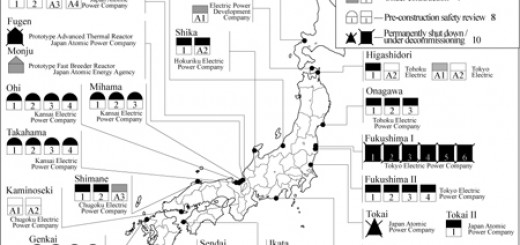Asian Nuclear Power Plants: Current Status and Future Plans Nuke Info Tokyo No. 122
The maps on pages 6 and 7 show nuclear power plants in Japan and the rest of East Asia and nuclear facilities in Japan only. The maps are current for January 2008. No changes have been made to the Japanese maps since January 2007 (NIT 116). However, there are several changes and additions to the map of East Asian nuclear power plants.
In China during 2007, Tianwan 2 (1000 MW, PWR-VVER) was connected to the grid on May 14 and began commercial operation on August 16. Tianwan 1 (1000 MW(e), PWR-VVER) was connected to the grid in 2006, but began commercial operation in June 2007. Construction of Qinshan II-4 (610 MW, PWR) began on January 28 and construction of Hongyanhe 1 (1000 MW, PWR) began on August 18.
In South Korea, construction of Shin-Kori 2 (960 MW, PWR) began on June 5 and construction of Shin-Wolsong 1 (960 MW, PWR) began on November 20. Ground was broken on November 28 for the construction of Shin Kori-3 and Shin Kori-4 (both APR-1400s).
Most of China’s “planned” nuclear power plants have been on the books for some time, but China’s plans are subject to abrupt change, so we have not previously included most of them on this map. If we tried to show all the proposed sites in China, we would have to redo the map completely, so we have only included those planned for the near future.
The Taishan site is a new site, but a contract for 2 EPRs (1700 MW each) was signed with Areva on November 26, so we assume they are serious about building a nuclear power plant there. Earlier in the year, an agreement with Westinghouse to build two AP1000s each at Sanmen and Yangjiang was changed suddenly. The plan is now for Westinghouse to build plants at Sanmen and Haiyang and for China Guangdong Nuclear Power Company to build CPR-1000s at Yangjiang.
Besides these, an agreement was signed on November 6 with Atomstroyexport for two more VVERs at Tianwan and site preparation began at Fiangjiashan, so it appears that China’s nuclear plan is moving ahead in earnest. However, it remains to be seen whether China will realize its aim of increasing nuclear capacity fivefold to 40 GW by 2020 and a further three to fourfold to 120-160 GW by 2030.
For South Korea, besides construction of the new and planned plants shown on page 7, life extensions for old plants is a major issue. On 17 January 2008 the oldest plant, Kori-1, went back on line with a life extension of 10 years. Wolsong-1, which began operating in 1982, is the next in line for a life extension.
Japan, China, Taiwan and South Korea are the only countries with nuclear power plants in East Asia. (In South Asia, India and Pakistan have nuclear power plants (see article on page 8).) However, several countries in South-East Asia have plans at varying stages of development. The most notable are outlined below.
On August 29 it was announced that Vietnam Prime Minister Nguyen Tan Dung had endorsed a plan for 2-3 nuclear power plants with a total capacity of 8,000 MW to be built by 2025. A decision on construction of the first plant is not expected until 2008.
In Indonesia, due to domestic opposition (see NIT 119 , 120), not to mention the aftershock from the earthquake at Kashiwazaki-Kariwa, it now seems certain that the plan to build four 1,000 MW reactors on the Muria Peninsula in Central Java will be delayed. Indonesia planned to call tenders by 2008 and begin construction in 2010, but in the absence of a presidential decision the plan cannot proceed.
This year Thailand announced a plan to begin operating the first two of four 1,000-MW reactors by 2020 and a second pair in 2021. No site has yet been selected.
Philip White (NIT Editor)



